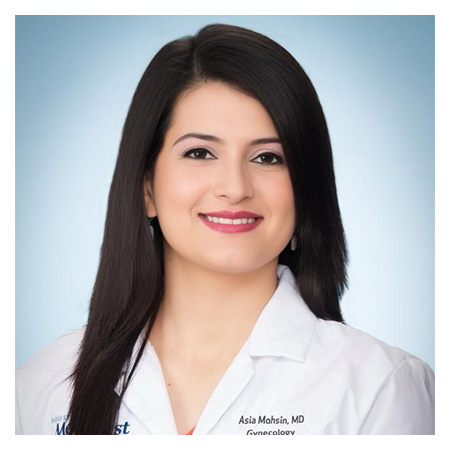Facelift and Removal of a Parathyroid Adenoma with Hidden Scar
 Asia Mohsin, MD, a Houston-area obstetrician / gynecologist, suffered from insomnia, fatigue, excessive thirst, recurrent urinary tract infections, and gastroesophageal reflux disease beginning in 2017. In the years that followed, she presented twice in an emergency department with severe chest pains. Ultimately, she was found to have higher-than-normal levels of calcium in her blood, associated with elevated parathyroid hormone.
Asia Mohsin, MD, a Houston-area obstetrician / gynecologist, suffered from insomnia, fatigue, excessive thirst, recurrent urinary tract infections, and gastroesophageal reflux disease beginning in 2017. In the years that followed, she presented twice in an emergency department with severe chest pains. Ultimately, she was found to have higher-than-normal levels of calcium in her blood, associated with elevated parathyroid hormone.
“Between 2017 and 2024, I was sick and seeing multiple doctors, all of whom were friends, even though I’ve always advised against this,” Dr. Mohsin says. “An ENT at a well-known hospital in Houston recommended parathyroid surgery, but I had a busy medical practice, a year-old son, and my father was hospitalized with cancer, so I just kept going. The surgery would involve a neck incision, and I didn’t want a visible scar. Finally, I realized that I needed to stop and take some time for myself.”
In 2024, she called cardiothoracic and vascular surgeon Naveed Saqib, MD, a friend and associate professor at McGovern Medical School at UTHealth Houston, to ask whom he would trust to perform a parathyroidectomy. He recommended Ron Karni, MD, chief of the Division of Head and Neck Surgical Oncology and an associate professor who holds joint appointments in the Department of Otorhinolaryngology and the Division of Hematology/Oncology at the medical school. Dr. Karni’s practice focuses on thyroid and parathyroid surgery.
“I asked around and found that many of my friends know Dr. Karni, so I decided to schedule an appointment for a second opinion and see what he could offer me,” Dr. Mohsin says. “I also wanted to include a facelift during the surgery.”
Dr. Karni could offer the full range of technology and surgical approaches available for parathyroid surgery. “Dr. Mohsin had a large parathyroid adenoma that was visible on neck ultrasound, so we didn’t need to do further, more precise imaging,” he says. “The most common approach to parathyroidectomy is a standard incision on the lower neck. We offer our patients minimally invasive techniques that include endoscopic and robotic surgery with scarless or scar-hiding approaches through the mouth, armpit, chest, and at the hairline.”
She also saw facial plastic and reconstructive surgeon Tang Ho, MD, director of the Texas Center for Facial Plastic Surgery in the Department of Otorhinolaryngology. As colleagues in the same department, Dr. Ho and Dr. Karni often work together on cases.
“By using the same approach for the parathyroidectomy that we use for a facelift – an incision in the submental triangle under the chin – the scar can be very well hidden and nearly invisible,” says Dr. Ho, who is director of the Division of Facial Plastic and Reconstructive Surgery, an associate professor in the department, and director of the Facial Plastic and Reconstructive Surgery Fellowship at UTHealth Houston. “If the patient also has been considering a facelift, performing these surgeries at the same time makes sense. By combining a cosmetic procedure with a medical procedure, the patient goes under anesthesia only once and benefits from some savings as well.”
For Dr. Mohsin’s surgery, Dr. Ho began the procedure with the incision for the face and neck lift, allowing Dr. Karni to remove the parathyroid adenoma through the incision. He completed the procedures by performing a deep-plane facelift, blepharoplasty, and temporal brow lift.
“The parathyroid surgery was like a miracle,” Dr. Mohsin says. “It was as if something in my body was reactivated. All my symptoms vanished, and most importantly, I’m sleeping well. And it was wonderful to be able to benefit from the facelift at the same time.”
The Department of Otorhinolaryngology at UTHealth Houston is a nationally recognized high-volume center for thyroid and parathyroid surgery, performing six to 10 surgeries each week. “We’ve created a smooth process for patients from diagnosis through workup, surgery, and discharge,” Dr. Karni says. “Good outcomes require surgical skill, state-of-the-art equipment, and a high level of team efficiency. We’ve put all of that together in a tailored package to improve the patient experience.”
The Texas Center for Facial Plastic and Reconstructive Surgery is well known for comprehensive aesthetic and reconstructive care of the face and neck. In addition to the full range of cosmetic procedures, the center provides facial reanimation for patients with facial paralysis, rhinoplasty for nasal obstruction and deformity, reconstructive surgery following skin cancer removal, microvascular free-tissue transfer, and maxillofacial trauma repair.